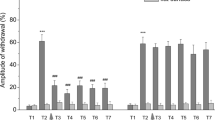Conclusions
-
1.
In experiments on conscious, loosely restrained rabbits, using a subcutaneously administered undecapeptide, substance P, in doses of 250 μg/kg, behavior and neuron activity was studied in the visual and sensorimotor areas of the neocortex and in the hippocampus during elicitation of the defense reflex conditioned to light flashes and conditioned inhibition.
-
2.
Introduction of sP evoked a short-term loss of motor reactions to the reinforcing stimulus; a lowering in probability of movements to reinforced and inhibitory light flashes; and a prolonged quickening of heartrate and slowing of breathing rate.
-
3.
The background action of sP, among the majority of investigated neurons responding to stimulus presentations, resulted in a fall in background activity and a weakening of excitatory and strengthening of inhibitory response components, especially to the painful reinforcing stimulus. Some neurons showed an increase in excitatory reactions.
-
4.
Bioelectric indicators reflecting a strengthening of inhibitory hyperpolarization processes during internal inhibition were unaffected: inhibitory background pauses and evoked activity in cerebral cortex neurons, together with corresponding slow potential fluctuations, were unchanged by sP.
Similar content being viewed by others
Literature cited
L. I. Bol'shev and I. V. Smirnov, Statistical Tables [in Russian], Nauka, Moscow (1965).
O. S. Vinogradova, The Hippocampus and Memory [in Russian], Nauka, Moscow (1975), p. 333.
I. P. Pavlov, Twenty Years' Objective Study of Higher Nervous Activity (Behavior) in Animals [in Russian], Nauka, Moscow (1973).
V. G. Skrebitskii, Regulation of Excitatory Activity in the Visual Analyzer [in Russian], Meditsina, Moscow (1977), p. 159.
G. I. Shul'gina, “Slow potentials and cortical neuron impulses during internal inhibition,” Zh. Vyssh. Nerv. Deyat.,26, No. 5, 962 (1976).
G. I. Shul'gina, Bioelectric Cerebral Activity and the Conditioned Reflex [in Russian], Nauka, Moscow.
G. I. Shul'gina and A. V. Korinevskii, “The reinforcing stimulus and its mechanism of action,” Zh. Vyssh. Nerv. Deyat.,25, No. 5, 1011 (1975).
G. I. Shul'gina and I. V. Pavlova, “The role of cholinergic inhibition and disinhibiting influences in the mechanism of reinforcement and internal inhibition,” Zh. Vyssh. Nerv. Deyat.,32, No. 4, 616 (1982).
S. P. Duckies and S. H. Buck, “Substance P in the cerebral vasculature: depletion by capsaican suggests a sensory role,” Brain Res.,245, No. 1, 171 (1982).
U. S. Euler and J. H. Gaddum, “An unidentified depressor substance in certain tissue extracts,” J. Physiol.,72, No. 1, 74 (1931).
R. C. A. Frederickson and P. D. Gesellchen, “Analgesic and other activities of substance P and fragments,” in: Neuropeptides and Neural Transmission, Proceedings of UNESCO-IBRO Symposium, Jablonna, June 2–4, 1979, New York (1980), p. 111.
V. Fujita and T. Sato, “Intracellular records from hippocampal pyramidal cells in the rabbit during theta rhythm activity,” J. Neurophysiol.,27, No. 6, 1011 (1964).
K. Hecht, P. Dehme, I. Ljowschina, M. Poppei, E. Wachtel, and M. Airapetjanz, “Peptide als lern- und gedächtnisaktive Substanzen,” Wissenschaftliche Zeitschr. der Humboldt, Univ. Berlin, Math., Nat. R.,29, 655 (1980).
J. D. Naranjo and J. Del Rip, “Differential effects of D-Ala2-analogues of enkephalins on substance P-induced analgesia in rodents,” Eur. J. Pharmacol.,82, No. 3–4, 213 (1982).
P., Oehme, M. Bienert, K. Hecht, and J. Bergmann, “Substanz P Ausgewählte Probleme der Chemie, Biochemie, Pharmakologie, Physiologie und Pathophysiologie.” Heft 12, Beitrage zur Wirkstofforsch., DDR, Berlin (1981), pp. 128, 142, 155.
M. Randic, E. Carstens, M. Zimmermann, and D. Klumpp, “Dual effects of substance P on the excitability of single cutaneousprimari afferent C and A fibers in the cat spinal cord,” Brain Res.,233, No. 2, 389 (1982).
P. Skrabanek and D. Powell, “Substance P,” in: Annual Research Reviews, Vol. 2, Eden Press Inc. (1980).
Z. Screniawski, A. Czionkowski, P. Janicki, J. Libich, and S. W. Gumilka, “Pain transmission and analgesia,” in: Neuropeptides and Neural Transmission, Proceedings of UNESCO-IBRO Symposium, Jablonna, June 2–4, 1979, New York (1980), p. 121.
G. W. Tregear, H. D. Niall, J. T. Potts, Jr., S. E. Leeman, and M. M. Chang, “Synthesis of substance P,” Nature New Biol. (London),232, 87 (1971).
S. Watanabe, M. Konishi, and O. Creutzfeldt, “Postsynaptic potentials in the cat's visual cortex following electrical stimulation of afferent pathways,” Exptl. Brain Res.,1, No. 3, 272 (1966).
A. M. Wein, K. Radaschak, R. Biniauraschwwili, P. Oehme, and K. Hecht, “Substanz P-Blutspiegel in der Vorschlafperiode von schlafgestörten Neurotikern und Patienten mit Smerzsyndrom (vorläufige Mitteilung),” in: Experimentelle Neurose, Issue No. 3, Humboldt, Univ. Berlin (1980), p. 757.
Author information
Authors and Affiliations
Additional information
Translated from Zhurnal Vysshei Deyatel'nosti imeni I. P. Pavlova, Vol. 34, No. 2, pp. 273–282, March–April, 1984.
Rights and permissions
About this article
Cite this article
Shul'gina, G.I., Levshina, I.P., Melekhova, A.M. et al. Effect of substance P on behavior and cortical neuron activity during learning in rabbits. Neurosci Behav Physiol 16, 111–118 (1986). https://doi.org/10.1007/BF01186508
Received:
Issue Date:
DOI: https://doi.org/10.1007/BF01186508



